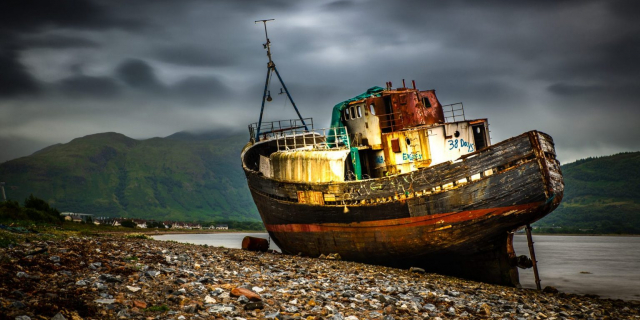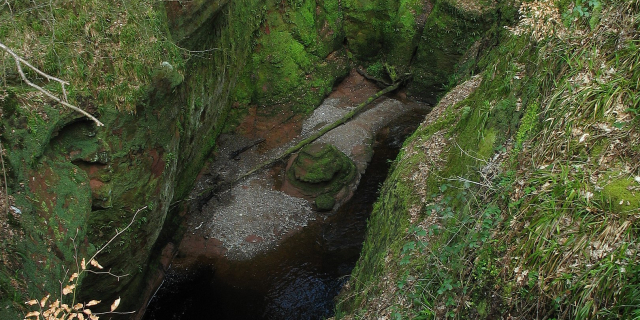Dunstaffnage Castle
Dunstaffnage Castle (Scottish Gaelic: Caisteal Dhùn Stadhainis) is a partially ruined castle in Argyll and Bute, western Scotland. It lies 3 miles (5 km) NNE of Oban, situated on a platform of conglomerate rock on a promontory at the south-west of the entrance to Loch Etive, and is surrounded on three sides by the sea. The castle and the nearby chapel ruin have been a Historic Scotland property since 1958. Both are Scheduled Ancient Monuments.
The castle dates back to the 13th century, making it one of Scotland's oldest stone castles, in a local group which includes Castle Sween and Castle Tioram. Guarding a strategic location, it was built by the MacDougall lords of Lorn, and has been held since the 15th century by the Clan Campbell. To this day there is a hereditary Captain of Dunstaffnage, although they no longer reside at the castle. Dunstaffnage is maintained by Historic Environment Scotland, and is open to the publ...Read more
Dunstaffnage Castle (Scottish Gaelic: Caisteal Dhùn Stadhainis) is a partially ruined castle in Argyll and Bute, western Scotland. It lies 3 miles (5 km) NNE of Oban, situated on a platform of conglomerate rock on a promontory at the south-west of the entrance to Loch Etive, and is surrounded on three sides by the sea. The castle and the nearby chapel ruin have been a Historic Scotland property since 1958. Both are Scheduled Ancient Monuments.
The castle dates back to the 13th century, making it one of Scotland's oldest stone castles, in a local group which includes Castle Sween and Castle Tioram. Guarding a strategic location, it was built by the MacDougall lords of Lorn, and has been held since the 15th century by the Clan Campbell. To this day there is a hereditary Captain of Dunstaffnage, although they no longer reside at the castle. Dunstaffnage is maintained by Historic Environment Scotland, and is open to the public, although the 16th century gatehouse is retained as the private property of the Captain. The prefix dun in the name means "fort" in Gaelic, while the rest of the name derives from Norse stafr-nis, "headland of the staff".
Before the construction of the castle, Dunstaffnage may have been the location of a Dál Riatan stronghold, known as Dun Monaidh, as early as the 7th century.[1] It was recorded, by John Monipennie in 1612, that the Stone of Destiny was kept here after being brought from Ireland, and before it was moved to Scone Palace in 843. However, Iona and Dunadd are considered more likely, given their known connections with Dál Riatan and Strathclyde kings.[2] Hector Boece records that the stone was kept at "Evonium", which has traditionally been identified with Dunstaffnage, although in 2010 the writer A. J. Morton identified Evonium with Irvine in Ayrshire.[3]
The MacDougallsThere was a castle here in the time of Somerled, Lord of the Isles.[4] However, the castle became the seat of Duncan MacDougall, Lord of Lorn and grandson of Somerled in the second quarter of the 13th century.[5] He had also travelled to Rome in 1237 and was the founder of nearby Ardchattan Priory.[6] Duncan's son Ewen MacDougall inherited his father's title in the 1240s, and expanded the MacDougall influence, styling himself "King of the Isles" though that title belonged to the MacDonalds. It is probable that Ewen built the three round towers onto the castle, and constructed and enlarged the hall inside.[7]
Following Alexander III's repulse of the Norse influence in Argyll, the MacDougalls backed the Scottish monarchy, and Ewen's son Alexander was made the first sheriff of Argyll in 1293. However, they supported the Balliol side during the Wars of Scottish Independence which broke out a few years later. Robert Bruce defeated the Clan MacDougall at the Battle of the Pass of Brander in August 1308. After a brief siege, King Robert took control of the MacDougall castle of Dunstaffnage.[8] He did not destroy it, as he did others, but appointed a constable and provisioned it, thinking to use it to guard the countryside and seaways. With the land he gave his friend, Angus Og Macdonald, Lord of the Isles, that included much of the MacDougall lands, including nearby Mull, the castle could be well used for that purpose by the Isleman.
Royal fortressNow a Crown property, Dunstaffnage was controlled by a series of keepers. James I seized the castle in 1431, following the Battle of Inverlochy, as his enemies were hiding inside. In 1455 James Douglas, 9th Earl of Douglas stayed at Dunstaffnage, on his way to treat with John MacDonald, Lord of the Isles.[9] This followed James II's attack on Douglas power, and led to the signing of the Treaty of Westminster-Ardtornish. A later keeper, John Stewart of Lorn, was a rival of Alan MacDougall, and was stabbed by his supporters on his way to his marriage at Dunstaffnage Chapel in 1463, although he survived long enough to make his vows. Although MacDougall took the castle, he was ousted by James III, who granted Dunstaffnage to Colin Campbell, 1st Earl of Argyll in 1470.[10]
 The south facade of Dunstaffnage CastleClan Campbell
The south facade of Dunstaffnage CastleClan Campbell
The Earls of Argyll appointed Captains to oversee Dunstaffnage, and keep it in readiness, on their behalf. Changes were made to the buildings, particularly the gatehouse, which was rebuilt around this time. The Campbells were loyal allies of the royal house, and Dunstaffnage was used as a base for government expeditions against the MacDonald Lords of the Isles, among others, during the 15th and 16th centuries. James IV visited Dunstaffnage on two occasions.[9]
Dunstaffnage saw action during the Civil War, holding out against Montrose's army in 1644. The castle was burned by royalist troops, following the failure of Argyll's Rising in 1685, against the Catholic James VII.[11] During the Jacobite risings of 1715 and 1745, the castle was occupied by government troops. Flora MacDonald, who helped Bonnie Prince Charlie to escape from Scotland, was briefly imprisoned here while en route to imprisonment in London.[9]
According to W. Douglas Simpson the castle appears in Tobias Smollet's Humphry Clinker, which although not naming Dunstaffnage, presents "a fair picture of life in the castle in the third quarter of the eighteenth century".[12]
Decline and restorationThe Campbells continued to add to the castle, building a new house over the old west range in 1725. However, the rest of the castle was already decaying. In 1810 an accidental fire gutted the gatehouse, and the Captains ceased to live here, moving to Dunstaffnage House some 2 km to the south-east.[9] Tenants lived in the 1725 house within the castle until 1888.[13]
Restoration work was undertaken in 1903 by the Duke of Argyll, the castle's owner. This was followed in 1912 by a court case, in which the Court of Session ruled that Angus Campbell, the 20th hereditary Captain, had right of residence notwithstanding the Duke of Argyll's ownership. Works were delayed by World War I, and the planned total restoration was never completed.[14] In 1958, the 21st Captain and the Duke agreed to hand the castle into state care,[13] and it is now open to the public as a Historic Environment Scotland property.[15][16]
































Add new comment